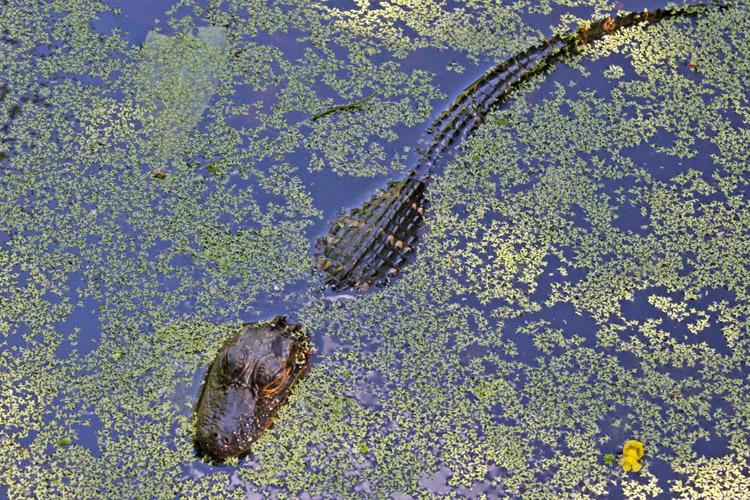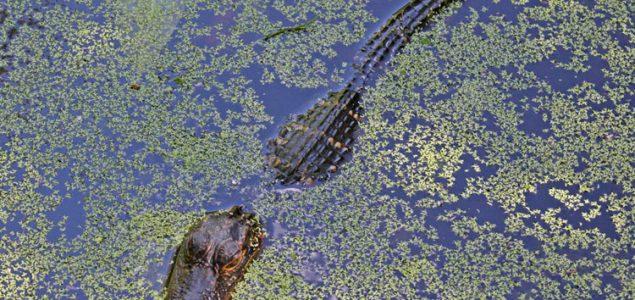On the bridge over the river, a large crowd is pointing cell phones at an alligator mississippiensis. The grownups giggle like kids. Londoners standing next to me confide that Paris with its “Mona Lisa” pales in comparison to these prehistoric beasts at Myakka River State Park. Sometimes I think they’re on the Park payroll.
American alligators are descendants of reptiles, which inhabited the planet 150 million years ago. Their descendants survived the huge asteroid, which crashed into the Gulf of Mexico 65 million years ago to wipe out much of life on earth, including the dinosaurs. The American alligator appeared only six to twelve million years ago in lands east of the Mississippi, and much later in Florida, a newborn in geological terms.
In the last century in Florida, the “saurians” as they were called back then, were not far from extinction themselves. Trophy seekers lusted after alligators, which they usually got with a lot of help from poor blacks who for a pittance would do the dirty work. But it was the professional hunters who decimated the populations. Remember your mother’s alligator shoes and handbag? Like snowy egrets killed for their feathers, the gators were victims of a fashion craze and exterminated by the thousands before being designated a protected species.
Protection brought a rebound, which canoeists and kayakers now experience in winter on Myakka’s Lower Lake. When fresh water is at a premium, it can be so difficult for paddlers to maneuver that sometimes feel they could be snapped up should an opportunity arise.
For park visitors, the riverboat ride serves up alligators at a distance. They haul up out of the river to sun themselves providing great photo ops. Elsewhere in the park –at the end of Power Line Road or the picnic areas near the concession stand are just two areas– landlubbers can experience these beautiful creatures steaming by, most of their 1000-pound bulk concealed by water stained black with the tannin of oak leaves.
For a couple of years, the Rincon Writers Group met regularly at a picnic table on the water. Creativity soared under the beautiful palm/oak canopy as we read aloud our latest efforts, while trying not to be distracted by the gorgeous anhinga atop a live oak drying her wings, a limpkin fishing in the shallows or the great blue heron squawking loudly as he flapped by. Alligators stopped the proceedings. We shuddered as we watched a snowy egret feeding in the shallows, under the nose of a sleeping alligator.
Gators are thought to stick to watery places but sometimes, they turn up in the woods to surprise hikers who assume they’re just another log. I’ve had my own share of surprises. Years ago, when I didn’t know better I moved in for a close up of new hatchlings just out of the nest. Luckily “Mama Gator”, who will fiercely defend her offspring, was far enough away that I got away in time. Once, at Carlton Reserve, I found myself between an alligator and a diamondback rattlesnake. I chose the rattlesnake when I remembered William Bartram’s description of the rattler as “magnanimous”, a word no one ever used to describe an alligator.
What does an alligator have in common with an elephant? They could not appear to be more different. One’s a carnivore, the other an herbivore; one’s a wetland species, the other a creature of savannas. Both are a keystone species, essential to the balanced functioning of their habitats. In the Everglades, alligators scrape out watering holes, which enables them and most of the neighborhood– herons, egrets and other species– to survive months of drought.
In summer, when those Londoners are back home tending their flower gardens, Floridians run into alligators traveling far afield in ditches, on golf courses and even in swimming pools. Sloshing down a trail in the rainy season, I keep an eye out but in drier times, they are far from my mind until a huge splash in a nearby ditch startles me. Photographing alligators is addicting, as my friend Bonnie Samuelson will tell you. We file away great places to see them, including the Myakka River.
When I leave the Myakka River State Park at dusk, I always pause at the bridge to watch the gaggle of tourists enthralled by an alligator gobbling up a tilapia. Then he steams up the river, undeniably master of the place. May it always be so.

